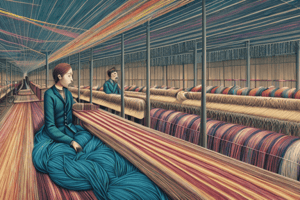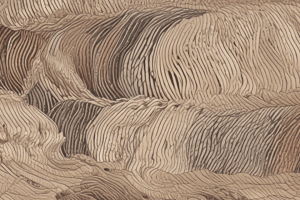Podcast
Questions and Answers
What is textile merchandising primarily concerned with?
What is textile merchandising primarily concerned with?
- Planning, buying, selling, and displaying textile products. (correct)
- Managing customer interactions in stores.
- Developing manufacturing processes for textiles.
- Only purchasing products from manufacturers.
Which of the following is NOT a component of textile merchandising?
Which of the following is NOT a component of textile merchandising?
- Inventory Management
- Product Selection
- Employee Training (correct)
- Visual Merchandising
What role focuses on negotiating with suppliers for product pricing?
What role focuses on negotiating with suppliers for product pricing?
- Buyer (correct)
- Inventory Manager
- Merchandiser
- Visual Merchandiser
What trend in textile merchandising involves the use of eco-friendly materials?
What trend in textile merchandising involves the use of eco-friendly materials?
Which strategy helps in enhancing product visibility in stores?
Which strategy helps in enhancing product visibility in stores?
What challenge involves disruptions in material availability?
What challenge involves disruptions in material availability?
Which aspect of marketing and promotion is highlighted for textile products?
Which aspect of marketing and promotion is highlighted for textile products?
Which role is responsible for creating an engaging shopping experience through design?
Which role is responsible for creating an engaging shopping experience through design?
Flashcards are hidden until you start studying
Study Notes
Definition
- Textile merchandising refers to the planning, buying, selling, and displaying of textile products in a retail or wholesale environment.
Key Components
-
Product Selection
- Identifying trends and consumer preferences.
- Sourcing materials and products from manufacturers.
-
Pricing Strategies
- Setting competitive pricing based on cost, market demand, and consumer behavior.
- Implementing promotional pricing for sales events.
-
Inventory Management
- Monitoring stock levels to ensure adequate supply without overstocking.
- Utilizing inventory management systems to track product movement.
-
Visual Merchandising
- Designing attractive displays to enhance product visibility and appeal.
- Organizing store layouts to facilitate customer flow and promote textile products.
-
Marketing and Promotion
- Developing marketing campaigns to promote textile products.
- Utilizing social media and online platforms for wider reach.
Roles in Textile Merchandising
-
Merchandiser
- Responsible for planning and purchasing products.
- Analyzes sales data to forecast demand.
-
Buyer
- Selects products for purchase based on market trends and consumer needs.
- Negotiates with suppliers for pricing and delivery terms.
-
Visual Merchandiser
- Focuses on the aesthetic aspect of product display.
- Creates an engaging shopping experience through design.
Trends in Textile Merchandising
-
Sustainability
- Increased focus on eco-friendly materials and ethical sourcing.
-
Technology Integration
- Use of e-commerce platforms and digital tools for merchandising.
- Implementing data analytics for improved decision-making.
-
Customization
- Growing demand for personalized textile products.
- Offering custom designs and made-to-order services.
Challenges
-
Supply Chain Issues
- Disruptions affecting material availability and delivery times.
-
Market Competition
- Keeping up with fast fashion and changing consumer preferences.
-
Consumer Behavior
- Adapting to online shopping trends and shifts in purchasing patterns.
Importance
- Enhances the shopping experience and influences consumer choices.
- Drives sales and profitability within the textile industry.
Definition of Textile Merchandising
- Involves planning, buying, selling, and displaying textile products in retail or wholesale settings.
Key Components of Textile Merchandising
- Product Selection
- Focus on identifying consumer trends and preferences along with sourcing from manufacturers.
- Pricing Strategies
- Establish competitive pricing based on costs and market demand and leverage promotional pricing for sales.
- Inventory Management
- Maintain stock levels to balance supply and prevent overstocking using inventory tracking systems.
- Visual Merchandising
- Create attractive product displays and optimize store layouts to enhance customer flow and showcase products.
- Marketing and Promotion
- Design marketing campaigns across social media and online platforms to promote textile offerings effectively.
Roles in Textile Merchandising
- Merchandiser
- Plans and purchases products while analyzing sales data for demand forecasting.
- Buyer
- Selects products based on market trends and negotiates terms with suppliers.
- Visual Merchandiser
- Enhances product display aesthetics and designs engaging shopping experiences.
Trends in Textile Merchandising
- Sustainability
- Emphasizes eco-friendly materials and ethical sourcing practices.
- Technology Integration
- Adopts e-commerce and digital tools for merchandising and utilizes data analytics for decision-making.
- Customization
- Responds to rising consumer interest in personalized products by providing custom designs and made-to-order options.
Challenges in Textile Merchandising
- Supply Chain Issues
- Faces disruptions that impact material availability and delivery schedules.
- Market Competition
- Competes with fast fashion brands and rapidly changing consumer preferences.
- Consumer Behavior
- Must adapt to the growth of online shopping and evolving purchasing habits.
Importance of Textile Merchandising
- Enhances the overall shopping experience, directly influencing consumer choices and driving sales within the textile industry.
Studying That Suits You
Use AI to generate personalized quizzes and flashcards to suit your learning preferences.





